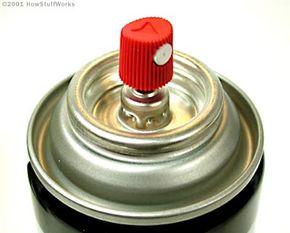Propellant and Product
An aerosol can contains one fluid that boils well below room temperature (called the propellant) and one that boils at a much higher temperature (called the product). The product is the substance you actually use -- the hair spray or insect repellent, for example -- and the propellant is the means of getting the product out of the can. Both fluids are stored in a sealed metal can.
There are two ways to configure this aerosol system. In the simpler design, you pour in the liquid product, seal the can, and then pump a gaseous propellant through the valve system. The gas is pumped in at high-pressure, so it pushes down on the liquid product with a good amount of force. You can see how this system works in the diagram below.
Advertisement
In this can, a long plastic tube runs from the bottom of the can up to a valve system at the top of the can. The valve in this diagram has a very simple design. It has a small, depressible head piece, with a narrow channel running through it. The channel runs from an inlet near the bottom of the head piece to a small nozzle at the top. A spring pushes the head piece up, so the channel inlet is blocked by a tight seal.
When you push the head piece down, the inlet slides below the seal, opening a passage from the inside of the can to the outside. The high-pressure propellant gas drives the liquid product up the plastic tube and out through the nozzle. The narrow nozzle serves to atomize the flowing liquid -- break it up into tiny drops, which form a fine spray.
Essentially, this is all there is to a simple compressed-gas aerosol can. In the next section, we'll look at the more popular liquefied gas design, which is just a little more elaborate.
